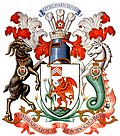Cardiff
Cardiff is the capital and biggest city of Wales. It is also the 11th biggest city in the United Kingdom.[1] Its name in the Welsh language is Caerdydd. A 2011 census says that around 346,100 people live in Cardiff. It is the most important city in Wales for tourism, culture, government, sport, transport, nightlife and business.
|
Caerdydd | |
|---|---|
| City and County of Cardiff | |
 | |
 Map of Cardiff with roads and borders | |
| Coordinates: 51°29′N 3°11′W / 51.483°N 3.183°WCoordinates: 51°29′N 3°11′W / 51.483°N 3.183°W | |
| Country | United Kingdom |
| Constituent country | Wales |
| Area | |
| • Land | 54.07 sq mi (140.03 km2) |
| [1] | |
| Population (2011) | |
| • Total | 346,100 |
Cardiff was declared a city in 1905, and it became the capital of Wales in 1955.[2]
History
The Romans built a fort here in about 55 AD. Later, a castle was built within the walls of the fort when the city was first founded.[3]
In 1404, Owain Glyndŵr set Cardiff on fire. Most of the buildings in Cardiff were made out of wood, so fire destroyed the city.[2][3]
Demographics
At the 2011 census, the biggest ethnic group in Cardiff is White (84.7%), other groups are Asian (8%), Black (2.4%), Arab (1.4%), Mixed (2.9%)[4]
Places
Cardiff has a big port that used to be known as Tiger Bay. It is now just called Cardiff Bay, and the Welsh Government works there. There are now lots of shops, pubs and restaurants in Cardiff Bay. Cardiff has an international airport, and is twinned with Nantes in France and Stuttgart in Germany. Cardiff has one of the largest stadiums in the United Kingdom, the Millennium Stadium, where important world sports matches and concerts happen. Other big stadiums in the city are the Cardiff City Stadium, where the main football team play, Cardiff Arms Park where the main rugby team play, and the SWALEC Stadium where cricket is played.
Three big rivers flow through Cardiff - the Taff, the Ely and the Rhymney.
Part of Cardiff is built on marshland.
Transportation

To get around, there are lots of bus routes and train lines in the city. There are two big train stations in Cardiff city centre, called Central station and Queen Street station, but there are also 18 other smaller stations in the city for local areas. There are lots of cycle paths in Cardiff on and off the road.
Education
Cardiff has a large university, with 33,000 students, making it the tenth-largest university in Britain.[5] The city also has 127 schools.[6]
Cardiff Media
Front wall of Cardiff Castlepart of the original Roman fort beneath the red stones
Cardiff old town hall (1860)
John Speed's map of Cardiff from 1610
St John the Baptist Church, Cardiff, the only medieval building next to Cardiff Castle to still be in city centre. Seen here in 1852
References
- ↑ "Population of Cities in United Kingdom (2021)". worldpopulationreview.com. Retrieved 2021-07-12.
- ↑ 2.0 2.1 "A comprehensive timeline of Cardiff's history - Cardiffians.co.uk". www.cardiffians.co.uk. Retrieved 2021-05-23.
- ↑ 3.0 3.1 "A History of Cardiff". www.localhistories.org. Archived from the original on 2012-10-02. Retrieved 2021-05-23.
- ↑ "Cardiff Population 2021 | Population UK". Retrieved 2021-07-12.
- ↑ "Facts and figures". Cardiff University. Retrieved 2021-05-23.
- ↑ "Cardiff Schools A to Z". apps8.cardiff.gov.uk. Retrieved 2021-05-23.











